Before driving, check with the Caltrans Highway Information Network (CHIN): 800-427-7623 and Caltrans Quickmap.
You must stop and put on chains when highway signs indicate chains are required. You can be cited by the California Highway Patrol and fined if you don't. You will usually have about a mile between "Chains Required" signs and the checkpoint to install your chains.
The California Department of Transportation (Caltrans) does not sell nor recommend specific brands of tire chains. It is best to check your vehicle manufacturer's specifications for use of tire chains/traction devices.
Chain Installation Chart (PDF) depicting the proper placement of traction devices for all vehicles.
During the winter months, motorists may encounter traction chain controls in the mountain areas within California. When chain controls are established, signs will be posted along the road indicating the type of requirement. There are Three Levels of Chain Requirements in California:
 Chains must be carried by vehicles using snow tires. All vehicles towing trailers must have chains on one drive axle. Trailers with brakes must have chains on at least one axle.
Chains must be carried by vehicles using snow tires. All vehicles towing trailers must have chains on one drive axle. Trailers with brakes must have chains on at least one axle.Truckers, see our Truck Chain Requirements page.
R-1 and R-2 are the most common conditions. A highway will often be closed before an R-3 condition is imposed. Some local areas may use variations of these designations. You must follow the directions on the signs posted for chain controls or any instructions given by Caltrans or CHP personnel at chain control check points, even if these are at variance with broadcast road condition reports or information contained herein.
1 Snow-tread Tires: The California Vehicle Code, Section 558 defines a snow-tread tire as follows, "A 'Snow-tread tire' is a tire which has a relatively deep and aggressive tread pattern compared with conventional passenger tread pattern". Snow-tread tires can be identified by examining the sidewall of the tire where the letters MS, M/S, M+S or the words MUD AND SNOW have been stamped into the sidewall.
2 Tire Traction Devices: The California Vehicle Code, Section 605 defines tire traction devices as follows: "Tire Traction Devices are devices or mechanisms having a composition and design capable of improving vehicle traction, braking and cornering ability upon snow or ice-covered surfaces. Tire traction devices shall be constructed and assembled to provide sufficient structural integrity and to prevent accidental detachment from vehicles. Tire traction devices shall, at the time of manufacture or final assembly, bear a permanent impression indicating the name, initials or trademark of the assembling company or primary manufacturer, and the country in which the devices were manufactured or assembled in final form. "
"
The full, searchable version of the California Vehicle Code is available at: Leginfo, the website for California Legislative Information.
Please note: The California Department Of Transportation (Caltrans) reserves the right to prevent any vehicle from entering a chain control area when it is determined the vehicle will experience difficulty in safely traveling the area.
Caltrans officials urge you to check road conditions often. To help keep abreast of changing conditions, Caltrans operates the Caltrans Highway Information Network which motorists may telephone 800.427.7623 for up-to-the-minute information in California and Western Nevada (Lake Tahoe/Reno Area). The network is updated as conditions change, and is voice-activated for safety and convenience.
See Caltrans QuickMap for a real-time, zoom-able California map of current traffic conditions including lane closures, CHP incidents, changeable message signs, chain controls, video cameras and more:
California does not have any specific dates when vehicles are required to carry chains. When the road is posted with a sign requiring chains, all heavy-duty vehicles (over 6,500 pounds gross weight) must be equipped with chains mounted on the tires in order to proceed. Depending on the severity of road conditions, some vehicles (passenger cars, 4-wheel drive vehicles with snow tires) may not be required to install chains at that point. The exceptions will be posted on the sign.
When the road is posted with a sign requiring chains, all heavy-duty vehicles (over 6,500 pounds gross weight) must be equipped with chains mounted on the tires in order to proceed. Depending on the severity of road conditions, some vehicles (passenger cars, 4-wheel drive vehicles with snow tires) may not be required to install chains at that point. The exceptions will be posted on the sign.
Tire traction devices are defined in the California Vehicle Code (VC) Section 605 as “devices or mechanisms having a composition and design capable of improving vehicle traction, braking, and cornering ability upon snow or ice-covered surfaces,” and include conventional link-type tire chains and cable chains, as well as other less conventional devices such as “Spikes Spyder.” When the term “chains” is used here, it means any “tire traction device” unless it specifically states link-type chain.
Automatic Traction Devices (A. T.D.'s) are used primarily on commercial vehicles, emergency vehicles, and busses. ATD's are devices mounted under the vehicle that sling chain segments under the inside drive wheels. These devices can be deployed by the driver when the need for extra traction is required. While they are legal in California and have been approved as a direct one-on-one replacement for conventional chains, vehicles with only ATD's may be required to add additional chains to outside wheels to comply with the California Chain Requirements Chart.
T.D.'s) are used primarily on commercial vehicles, emergency vehicles, and busses. ATD's are devices mounted under the vehicle that sling chain segments under the inside drive wheels. These devices can be deployed by the driver when the need for extra traction is required. While they are legal in California and have been approved as a direct one-on-one replacement for conventional chains, vehicles with only ATD's may be required to add additional chains to outside wheels to comply with the California Chain Requirements Chart.
Diagrams illustrating chain placement: Chain Requirements (PDF) .
There are some areas where such combinations are prohibited when chain controls are posted. These routes are marked with posted signs indicating the restriction.
Not usually, but under severe conditions, the California Department of Transportation (Caltrans) may require chains on the inside duals if conditions warrant.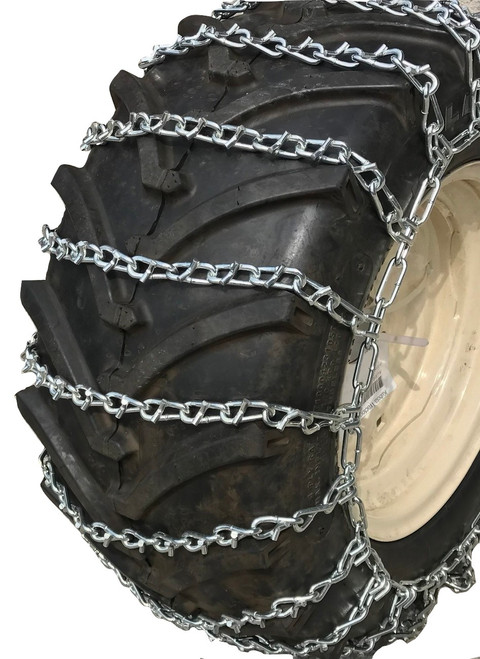 (If conditions are this severe, it may be better to postpone the trip.)
(If conditions are this severe, it may be better to postpone the trip.)
Chains are most often required in the higher mountain passes of northern California, such as Interstate 5 north of Redding, Interstate 80 over Donner Pass between Sacramento and Reno, Nevada, and US Highway 50 over Echo summit between Lake Tahoe and Sacramento. Chains are also sometimes required on State Route 58 near Tehachapi between Bakersfield and Mojave, Interstate 15 over Cajon Pass between Victorville and San Bernardino, and Interstate 5 over Tejon Pass between Los Angeles and Bakersfield. However, snow can fall unseasonably at higher elevations at many locations within California. Chains may be required at any time at these higher elevations when conditions warrant.
Motorists are advised to check the Caltrans website for current road conditions. Motorists may also call the Caltrans road information number at 800-427-7623.
They may be.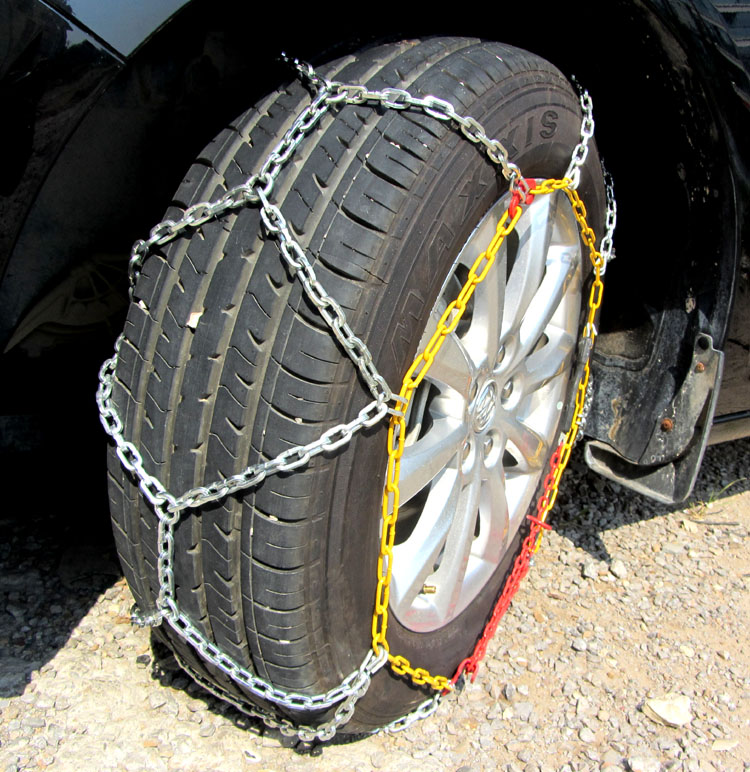 Snow tires have the designation “Mud & Snow” or an abbreviation such as “M-S,” “M+S,” or “M/S” marked on the tire sidewall. Tires without this designation are not considered snow tires. Snow tires must also have at least 6/32-inch (3/16”) of tread depth (about 1/2 of the original tread depth).
Snow tires have the designation “Mud & Snow” or an abbreviation such as “M-S,” “M+S,” or “M/S” marked on the tire sidewall. Tires without this designation are not considered snow tires. Snow tires must also have at least 6/32-inch (3/16”) of tread depth (about 1/2 of the original tread depth).
Usually. They are permitted for passenger cars and light trucks under virtually all conditions. Cables are not as effective as link-type chain under severe conditions at higher elevations and steep grades for “big-rigs” and may not be permitted depending on local conditions as determined by Caltrans. Whenever chain controls are posted over Donner Pass on Interstate 80, heavy trucks are usually required to have link-type chain on at least the main drive axle.
Vehicles without chains are not permitted to enter chain control areas and must return to a lower elevation where chains are not required.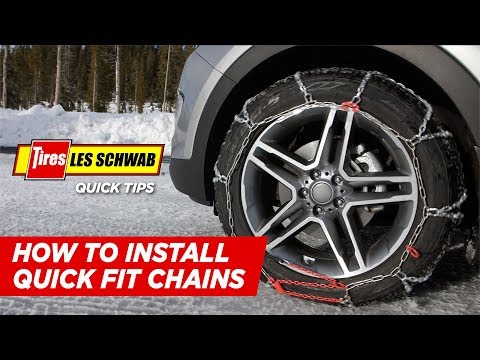 There is no provision to park vehicles at chain control check points.
There is no provision to park vehicles at chain control check points.
During inclement or unsettled weather conditions, Caltrans may set up truck screening check points at approaches to major mountain highways. When these screens are present, all heavy-duty trucks must stop and show Caltrans personnel that they have the required chains on board to proceed. Trucks without chains will be directed to return to a lower elevation until weather improves. There is no room available at higher elevations to park trucks not equipped with chains.
Studded snow tires are permitted in California from November 1 until April 30 each year. During this time, studded tires are permitted in any location within the state. Studded snow tires are not considered tire traction devices and may not be used in lieu of chains.
Yes. Even though weather conditions may not warrant the use of chains on 4-wheel-drive vehicles at a particular time, to enter a chain control area, you must have a set of chains (for one drive axle) for your vehicle in your possession. If conditions worsen or you have trouble controlling your vehicle, you must stop and install the chains.
Even though weather conditions may not warrant the use of chains on 4-wheel-drive vehicles at a particular time, to enter a chain control area, you must have a set of chains (for one drive axle) for your vehicle in your possession. If conditions worsen or you have trouble controlling your vehicle, you must stop and install the chains.
Yes. Even though weather conditions may not warrant the use of chains on passenger vehicles equipped with snow tires at a particular time, to enter a chain control area, you must have a set of chains (one pair) for your vehicle in your possession. If conditions worsen or you have trouble controlling your vehicle, you must stop and install the chains.
Yes. There is no exemption for heavy-duty commercial vehicles (over 6,500 pounds gross weight) equipped with snow tires. Chains must be installed on heavy-duty commercial vehicles whenever chain controls are posted.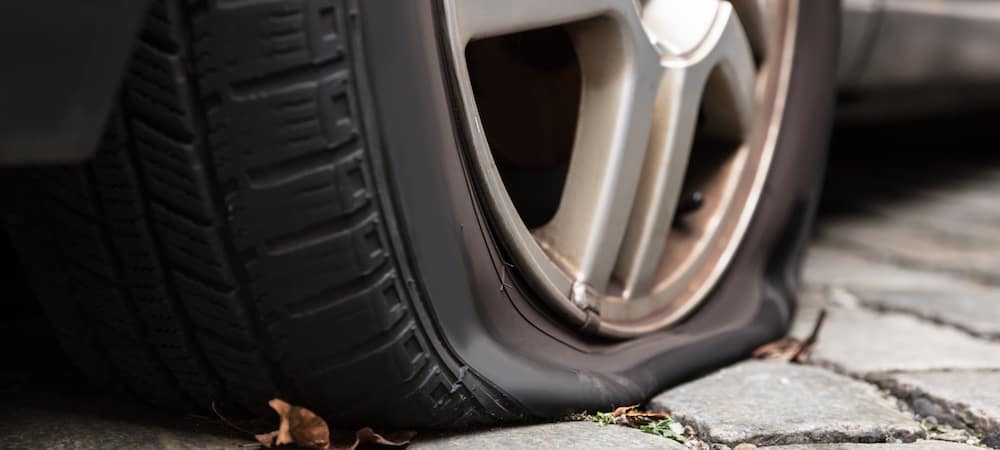
Yes. Studded snow tires are not considered tire traction devices and may not be used in lieu of chains.
Yes. Even though all-wheel drive systems may differ mechanically from conventional 4- wheel drive systems, for the purposes of chain control, all-wheel drive is considered the same as 4-wheel drive.
Yes. Many vehicles which will not accommodate conventional link-type chains will accommodate cable chains or other devices such as “Spikes Spider.” If your vehicle is not equipped with some type of tire traction device, it is neither safe nor lawful for you to enter a chain control area. If you choose not to install tire traction devices on your vehicle, you may not enter a chain control area.
Chains must be installed on the drive axle.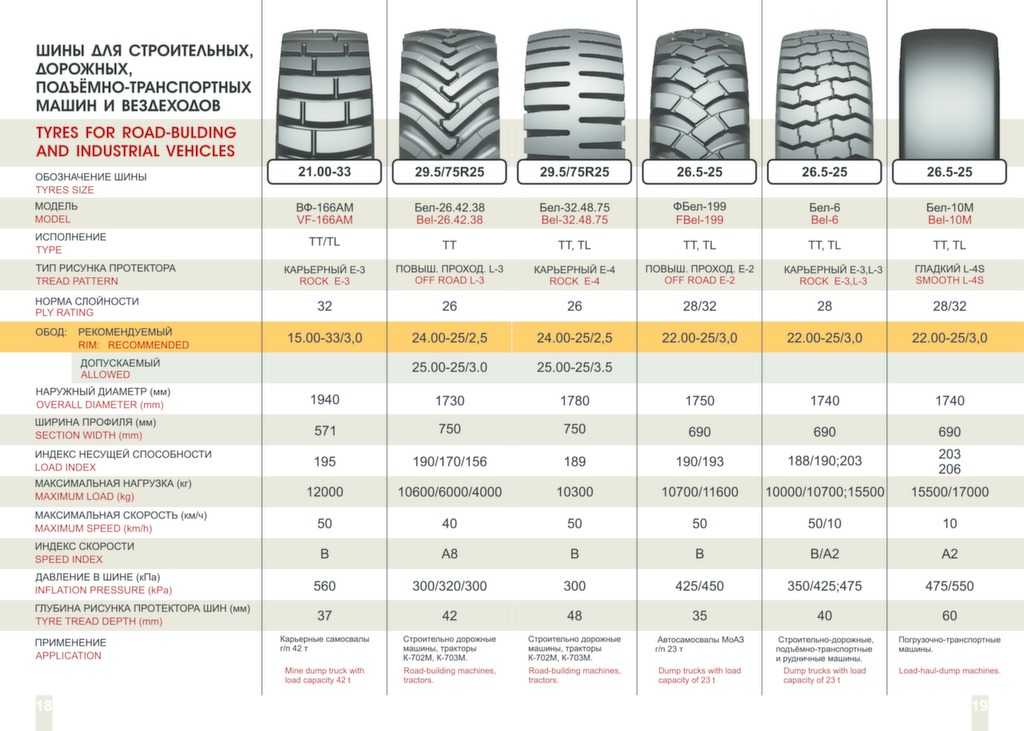 All-wheel drive vehicles and 4-wheel drive vehicles may have chains installed on either drive axle, but the rear axle is preferred, unless the vehicle manufacturer recommends the front axle.
All-wheel drive vehicles and 4-wheel drive vehicles may have chains installed on either drive axle, but the rear axle is preferred, unless the vehicle manufacturer recommends the front axle.
Yes, always.
Yes.
You must have at least one axle chained if the trailer is equipped with brakes.
Although Caltrans does not post signs with these designations nor use them to announce chain controls to the public, they are used internally within Caltrans and the CHP as a kind of shorthand to describe chain restrictions and may be included in traffic reports disseminated by various news outlets.
There are three primary categories of chain restrictions, as shown below:
Requirement 1 (R-1): Chains are required on all vehicles except passenger vehicles and light-duty trucks under 6,000 pounds gross weight and equipped with snow tires on at least two drive wheels.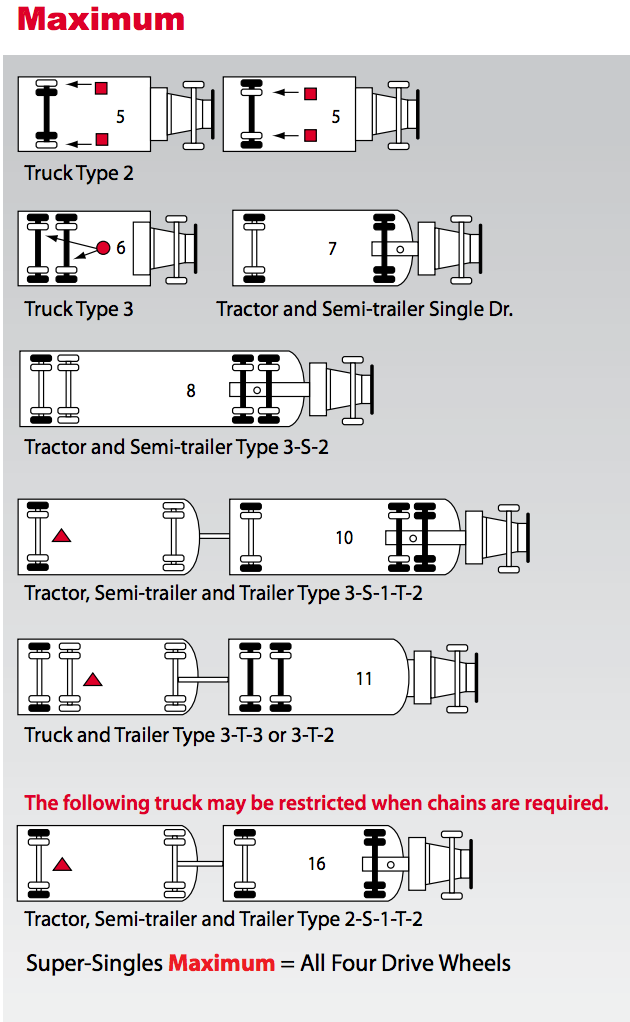 Chains must be carried by vehicles using snow tires. All vehicles towing trailers must have chains on one drive axle. Trailers with brakes must have chains on at least one axle.
Chains must be carried by vehicles using snow tires. All vehicles towing trailers must have chains on one drive axle. Trailers with brakes must have chains on at least one axle.
Requirement 2 (R-2): Chains are required on all vehicles except four-wheel-drive vehicles under 6,500 pounds gross weight and equipped with snow tires on all four wheels. Chains for one set of drive wheels must be carried by four wheel-drive vehicles using snow tires.
Requirement 3 (R-3): Chains are required on all vehicles without exception.
R-1 and R-2 are the most common conditions. A highway will often be closed before an R-3 condition is imposed. Some local areas may use variations of these designations. You must follow the directions on the signs posted for chain controls or any instructions given by Caltrans or CHP personnel at chain control check points, even if these are at variance with broadcast road condition reports or information contained herein.
Chain requirements are covered in the CVC, Section 605 and Sections 27450 to 27503. In addition, Section 26104 also covers laboratory testing (see below).
In addition, Section 26104 also covers laboratory testing (see below).
26104. (a) Every manufacturer who sells, offers for sale, or manufactures for use upon a vehicle devices subject to requirements established by the department shall, before the device is offered for sale, have laboratory test data showing compliance with such requirements. Tests may be conducted by the manufacturer.
(b) The department may at any time request from the manufacturer a copy of the test data showing proof of compliance of any device with the requirements established by the department and additional evidence that due care was exercised in maintaining compliance during production. If the manufacturer fails to provide such proof of compliance within 30 days of notice from the department, the department may prohibit the sale of the device in this state until acceptable proof of compliance is received by the department.
Tires of the same size may vary from manufacturer to manufacturer, especially mud and snow or off-road tread tires, so no snow chain online shop can 100% guarantee correct chain size.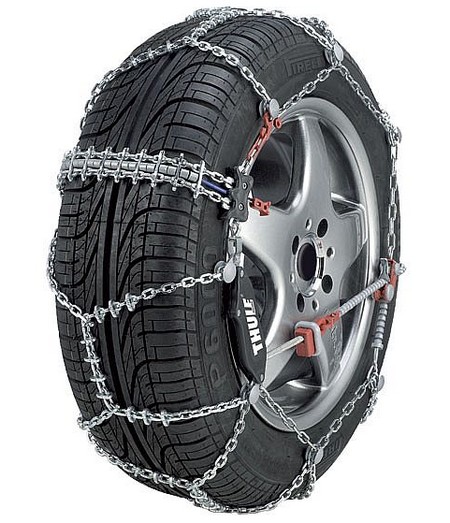 If the chains are installed with great effort, it is better to change the size.
If the chains are installed with great effort, it is better to change the size.
Most snow chains are now easy to install, however we strongly recommend that you practice putting them on when you buy them when dry before you encounter installation in snow or mud.
How much clearance is required for snow chains?
Clearance is the amount of space between a wheel and any obstacles such as the bodywork, brake systems or vehicle suspension.
Standard 9mm automotive chain needs about 15mm between the inside edge of the tire and any obstructions (to keep the chain moving), standard 4x4 chains can protrude 16mm from the wheel and so need a minimum clearance of 21mm.
Snow chains are sold in pairs and must be fitted to the drive wheels. This is generally considered sufficient and meets legal requirements on mainland Europe and European mountain roads. For some vehicles, four snow chains are recommended.
What are the best snow chains for a rear wheel drive vehicle such as a BMW or Mercedes?
Although one set of chains will meet legal requirements on snowy roads in continental Europe, rear wheel drive vehicles may be difficult to drive on snow and ice. The chains must be fitted to the rear wheels, meaning the steering wheels are left without enhanced traction. Additional complications may arise when the vehicle is heavily loaded in the trunk and therefore it may be advisable to install a second set of chains (if clearance permits).
By law, when driving in mountainous areas, you must only have snow chains for one axle. However, when driving 4 x 4 Some drivers prefer to use 4 chains (two sets). While one set of chains will provide sufficient traction in most conditions, there are significant benefits to using two sets. It is important to refer to the vehicle owner's manual as some manufacturers recommend two pairs.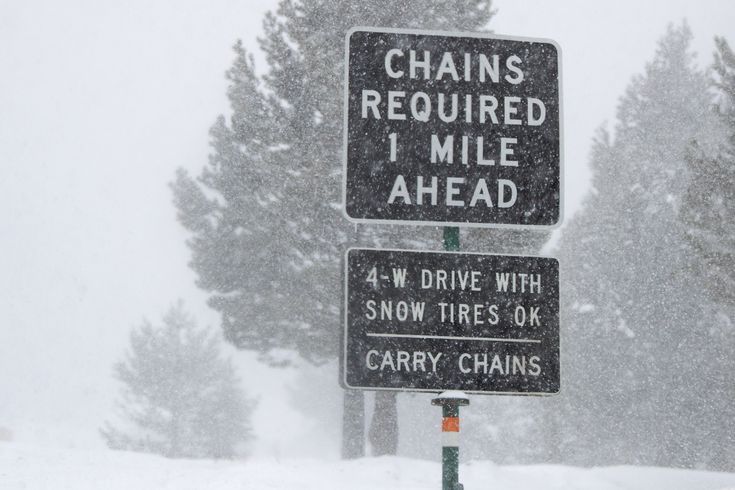
Some vehicles have very little space between the wheel and the vehicle's suspension or other obstacles, which means the chains can come into contact with the body, brakes or suspension with serious consequences. You can check if your car has a clearance problem by placing your hand in the wheel arch, on the tire, and feeling around the tire for obstacles that are approaching it, especially the back/inner wall of the tire. Move your hand from 915 hours along the back/inside of the wheel to check the distance between the wheel and any obstructions. Keep in mind that the chain sits on the rubber of the tire, so any obstacle that comes close to either side of the tire can be a problem. You also have to consider the proximity of the wheel arches when turning the steering if you are coming up to the front wheels, usually the compression point is at 3 or 9 o'clock at the back of the wheel when the steering is locked. (Check by locking the steering and placing your hand at the compression point to gauge the proximity of the arch to the tire, and do the same for the opposite lock.)
(Check by locking the steering and placing your hand at the compression point to gauge the proximity of the arch to the tire, and do the same for the opposite lock.)
For 16mm chains you need at least 21mm of clearance. Western manufacturers offer 7 mm chains for cars with insufficient clearance.
Belarus, Russia, Italy, Iceland, Serbia, Montenegro, Slovakia, Finland, Estonia do not regulate the use of chains.
But be careful if you are traveling by car in Europe, Canada, USA.
Prohibited for use in Denmark, the Netherlands. (Information may change over time, so it's best to double-check.)
In France and Switzerland there are no strict requirements for winter tires. Permitted in case of ice or deep snow in Belgium, Great Britain, Greece, Ireland, Lithuania, Latvia, Luxembourg, Sweden, Norway. Also, in most European countries, chains are required if there is an appropriate road sign.
For example, in Austria snow chains are allowed as an alternative to winter tyres. The fine for driving on summer tires from November 1 to April 15 can reach 5,000 euros.
From the beginning of 2018, in Europe, a winter tire must bear the "Alpine symbol" introduced in 2012 (3PMSF - Three Peak Mountain Snow Flake) to be considered as such. The M+S symbol is only valid for tires with an earlier release date, and then only until autumn 2024.
Twenty-two of the 47 European countries have strict requirements for the use of tires on commercial vehicles in winter conditions, and a growing number of local regulations mention the 3PMSF label.
Mandatory presence in the car from November to April: in Albania, Bosnia and Herzegovina, Bulgaria; Hungary, Macedonia, Slovenia, Croatia. Chains are obligatory if the weather conditions require it: in Romania, Andorra, Austria, Macedonia, Bulgaria, Hungary, Germany, Spain, Poland, Portugal, France, Czech Republic, Switzerland.
Some US states and Canadian provinces also require drivers to carry snow chains.
In general, in mainland Europe, the driver is responsible for equipping his car for all weather conditions. The driver can be fined if he does not use snow chains when they are needed, thus obstructing the normal flow of traffic or provoking accidents.
Snow chains are required by law on all European mountain roads. Roadside checks are being made and drivers can be fined if they don't have the kit in their vehicle.
European standards recommend driving with caution in snowy conditions at speeds not exceeding 30 miles per hour (48 km/h). When driving on mud, on hard surfaces, and even more so on paved areas, the speed must be limited more strongly and regulated, based on safety and tire safety considerations.
A gentle driving style is also important when using snow chains. Excessive acceleration and hard braking will put excessive pressure on the snow chains and may cause them to break.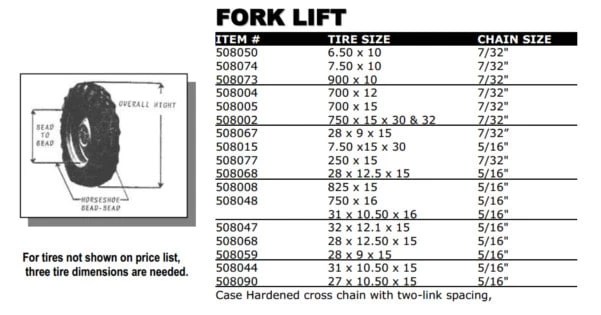
See also: How to choose snow chains
Next article: Sale of chains https://nn-cepi.ru/prodazha_czepej.html
Previous article: Anti-skid chains on mountain roads https://nn-cepi.ru/czepi-protivoskolzheniya-na-gornyikh-dorogakh.html
In view of the fact that winter or even studded tires are used almost everywhere in Russia in winter, snow chains are not widely used. Except, maybe, areas of complete impassability.
Contents
Whereas in Europe, on the contrary, few people use studded tires. And when traveling to ski resorts, on some roads you may encounter a mandatory requirement to use snow chains.
You will be informed about this by the relevant road sign. And the fact that you can have winter tires installed will not matter. So for peace of mind, it's better to have chains in the trunk.
New vehicles are often offered with different wheel/tyre sizes.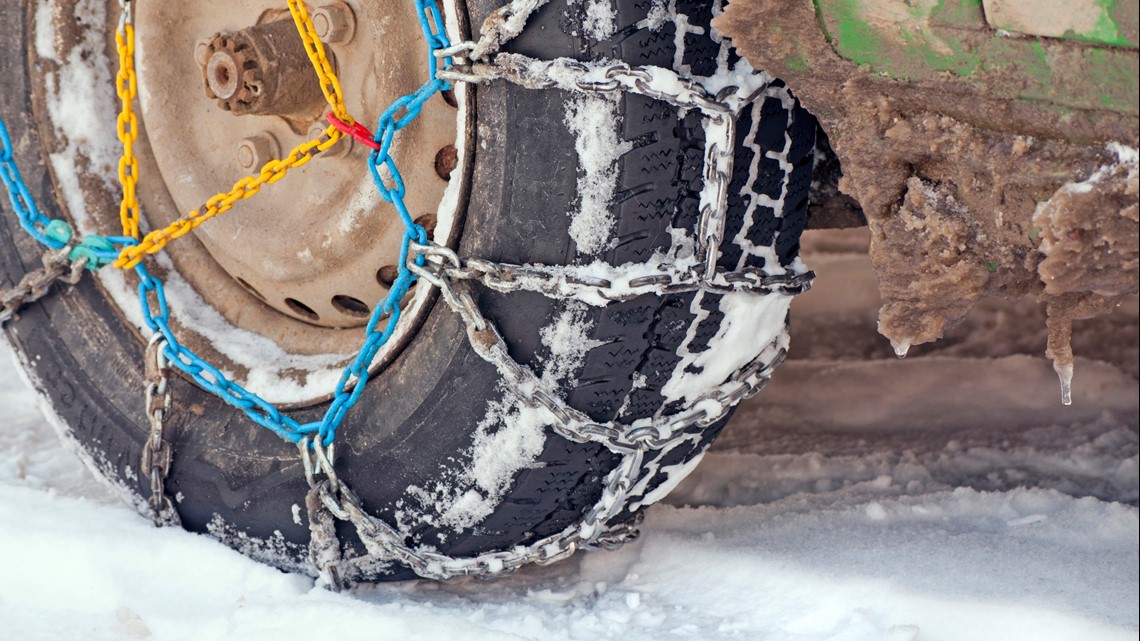 Some of them may not be suitable for fitting snow chains.
Some of them may not be suitable for fitting snow chains.
The problem is that installing chains adds a few centimeters to the width and diameter of the tires. This means that with some wheel/tire combinations, the snow chains will hit the body, suspension or parts of the braking system, which can lead to serious consequences.
Circuits can also interfere with the correct operation of electronic sensors mounted on the steering wheel.
The vehicle manual must clearly state which wheel size the manufacturer allows snow chains to be used with.
If the chains cannot be used with the wheels installed on your machine, then your only option is to buy a second set of wheels/tyres.
You should only use snow chains where the road surface is completely covered by compacted snow or ice.
If signs require the use of snow chains, they must be fitted to all vehicles. Including those equipped with both winter and studded tires.
If you attempt to use the chains on a road that has been cleared of snow, you risk damaging the road surface and the vehicle. If you damage the road surface, you may face a large fine.
Therefore, as soon as you reach a section of the road free of snow or ice, you must select a level place and remove the chains.
It can be quite inconvenient to install or remove chains, for example when the wheel arches are filled with snow and your gloved hands are wet and cold.
So when you buy chains, don't just throw them in the trunk and forget about them. The practice of installing them at home when the weather is warm and dry, and you feel much more confident when you have all the necessary tools at hand, will help to cope with them in more difficult weather conditions.
At least one pair must be used on the drive wheels. But two pairs are better, especially if you spend a lot of time in conditions where snow chains are a must.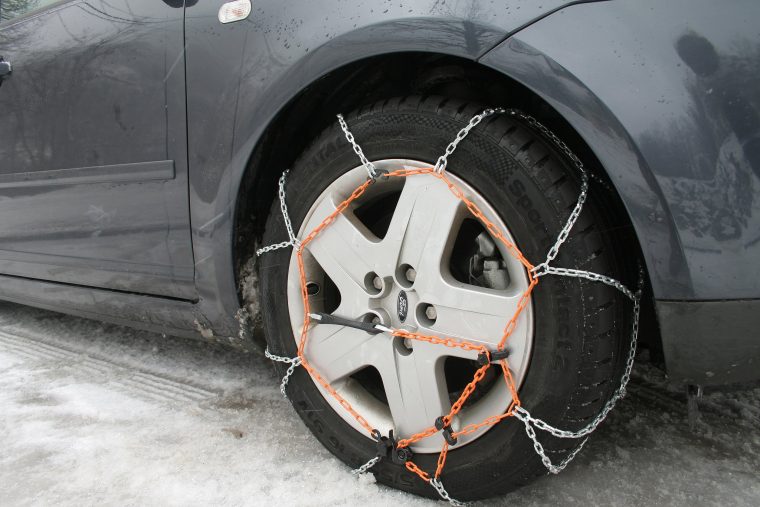
As a general guide:
As a general rule, traction control (a system that controls the amount of slip on the vehicle's drive wheels to prevent them from spinning during acceleration) should be disabled when snow chains are used.
It is important to drive carefully with snow chains fitted. For cars with chains, different countries have their own speed limits. Reduce speed when cornering and avoid sudden acceleration and braking.
A few tips for using chains:
